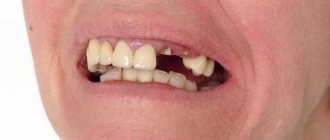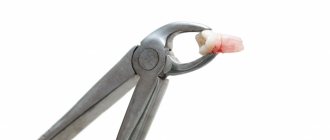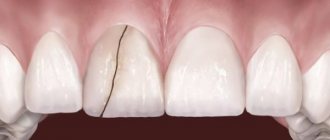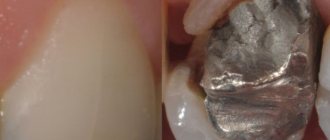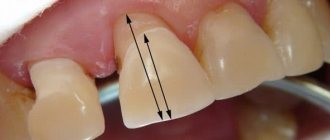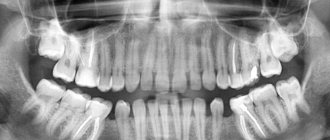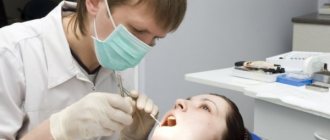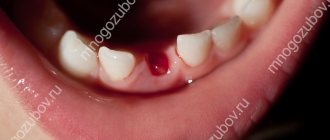Tooth extraction is a surgical procedure that can lead to complications. Especially if the operation is performed incorrectly when the root configuration is complex, the enamel is fragile, or when the tooth has crumbled but the root remains. Today we will look at all the reasons why fragments of teeth remain in the gums, and we will tell you whether it is worth removing fragments of crowns and roots.
Reasons why tooth fragments remain in the gums
Pieces of teeth remain in the following cases:
- Removal of wisdom teeth or multi-rooted teeth of complex configuration. If the tooth is severely damaged or the enamel is thinned, the walls may crack when it is removed. A small piece goes unnoticed by the doctor, and fragments measuring 1-3 mm are often not visible even on a control x-ray. In such cases, everything depends on the professionalism of the dentist - the more experience, the less likely it is that after tooth extraction there are fragments left in the gums.
- Crushing of an adjacent tooth during extraction. Sometimes, during the operation, a nearby tooth may be damaged due to fragile enamel or incorrect actions of the dentist. A small fragment gets into the fresh socket of the extracted tooth, and if it is not removed in time, it becomes a cause of discomfort, pain or suppuration.
- The crown crumbled, and the remains of the tooth were overgrown with gum. This applies to pulpless teeth - a living nerve would not allow the patient to delay a visit to the dentist. Most often this happens when the old filling is destroyed, and caries gradually eats up the crown part, reaching the roots. Remains of a tooth root overgrown with gums become a breeding ground for infection for neighboring units, negatively affecting the gums.
Important!
If you see a dentist in time, you can save on prosthetics or implantation. Today, doctors restore a tooth, even when a minimal amount of tissue from the crown of the tooth remains and the root is untouched by caries. The remainder of the tooth root is more vulnerable to pathogenic bacteria - it lacks integrity, and the microflora penetrates deep into the tooth very quickly. A weak, fragile and carious root cannot serve as a support for an artificial crown and must be removed.
Treatment of the tooth socket
After removal, it is necessary to treat the wound. The doctor, as a rule, suggests that the patient rinse the mouth with a special substance. This is a 2% sodium bicarbonate solution. In other cases, the dentist places a gauze pad on the wound, considering rinsing unnecessary.
After the operation, the person must firmly press the gauze to the wound with his teeth. After a quarter of an hour, when the bleeding has completely passed, the tampon is removed. During the day, you should not apply mechanical pressure to the wound.
Eating is allowed approximately 4-5 hours after the procedure. To avoid causing bleeding again, the patient should not drink hot drinks. You should rinse your mouth with tincture of medicinal herbs. These are calendula, oak bark, chamomile.
Washing the wound is done after each meal for 3 days, when the wound is completely healed.
How to rinse the socket correctly so that the blood clot that has formed on the socket, which prevents infection from entering the blood, is not washed away? This happens if the patient performs the procedure too intensively.
This leads to bleeding, inflammation of the socket and other complications:
- On the first day, do not rinse your mouth, but use baths. The solution is drawn into the oral cavity, kept for up to 5 minutes, and spat out. You should not drink or eat for an hour after this.
- Ask your doctor exactly when to rinse and for how many days after surgery. If the procedure is prescribed by a specialist, perform it very carefully so as not to harm the clot.
What is the best way to rinse:
- chlorhexidine;
- miramistin;
- saline solution;
- a solution of salt and soda, in a ratio of 50/50;
- decoction of medicinal plants (sage, chamomile, calendula, eucalyptus);
- solution of potassium permanganate in low concentration;
In modern times, almost all procedures are performed under anesthesia. However, many patients who want to remove a tooth root are tormented by the question: does it hurt? How will I feel during the process?
In this case, there is no need to cut the root; the doctor can take on the rest of the tooth.
Before the operation, local anesthesia is given by injection with an anesthetic drug. If there are remains above the root that you can grab with forceps, no one will cut the gum. Even if there is an incision, the patient will not feel any pain. It will be much more painful when the root becomes inflamed and an infection appears in the mouth, which subsequently spreads to the remaining teeth.
Read also: Tooth granuloma - what is it?
In general, removing a tooth root is no more painful than removing a whole tooth. In the first hours or even days after removal, there will be unpleasant sensations that bring discomfort, but painkillers solve this problem.
By what symptoms can you tell that there is a tooth fragment left in the gum?
An accurate diagnosis can only be made by a doctor during a face-to-face appointment. But there are some symptoms by which the patient can independently determine that after extraction the tooth remains in the gum:
- aching or throbbing pain in the socket area;
- swollen, reddened gums;
- pain when biting or pressing on the jaw;
- temperature increase;
- sensation of a foreign body in the thickness of the gums.
Sometimes, after removal, the fragments painlessly come out on their own and patients notice them only when the sharp edge of a dental fragment protruding from the gums cuts the tongue. But even in such painless cases, consultation with a specialist is required.
What to do after deletion
After any surgical intervention, you should follow all the dentist’s recommendations, as well as:
- do not eat for 2 hours after the procedure;
- cool the soft tissues of the face in the projection of the removed root;
- stop smoking for two days;
- take prescribed pain medication;
- make antiseptic applications;
- watch to see if other teeth are crumbling.
Sometimes after complex extractions, dentists prescribe antibiotics to patients. This appointment cannot be ignored - after a tooth is pulled out of the socket, a focus of infection forms in it, which can only be extinguished with the help of medications.
The following video schematically shows different methods for removing incisors, canines, molars and premolars of the lower and upper jaw.
Read also: Treatment after removal
What to do if there are tooth remains
- After the blow. If, due to an injury, half a tooth or only the root remains, in most cases, a crown can be built up. It all depends on the condition of the teeth, the complexity of the fracture, and a number of other factors.
- After removal. Fragments of tooth fragments may remain in the socket and come out a couple of days, a week or even a month later. And they can lead to inflammation, fever, and complications. When the hole is fresh, there is a risk of confusing the remainder of the tooth after extraction with the interroot septum and, when trying to remove the fragments, damage the unhealed wound, which will lead to alveolitis. Therefore, if you have any suspicions, you should consult a doctor as soon as possible for advice.
- After complete destruction of the crown due to caries. The best solution is to pull out the remains of the tooth, then perform prosthetics or insert an implant. The longer rotten stumps remain in the gums, the more negative the consequences and the more expensive the treatment.
Tooth root amputation as a treatment
In some cases, complete tooth root removal can be replaced by a tooth-saving operation called amputation. This is the removal of part of the tooth root, allowing you to save a healthy fragment. During the procedure, the affected area is cut off and the cavity is filled with osteoplastic mass.
Tooth-preserving extraction operations also include hemisection, in which part of the root system is removed along with the adjacent crown area. These two methods allow you to preserve the physiological function of the tooth and use it to install a bridge. It is important to understand: no doctor can guarantee that such a tooth will last a long time, since partial loss of the root will lead to a violation of the stability of the tooth. Therefore, if you notice that for a long time after root removal the tooth hurts or causes you other discomfort, you should definitely contact your doctor.
Which doctor should I contact if a tooth falls out but the root remains?
If you have a dental therapist whom you trust, contact him first. He will examine the gums and give a direction for CLT or X-ray. If there really are remains of a tooth left and the edge of the fragments is visible, the attending physician can get them out himself without sending his patient to the surgeon who performed the operation.
In cases where the removal took place in a random clinic, make a second appointment with the same doctor or get a second opinion on removing the fragment at another dental center.
Important!
When a toothache takes you by surprise at night, on a trip or out of town, do not wait until you visit your doctor - contact the first dentist you come across: it is important that you remove the fragment, relieve swelling of the gums, relieve pain, and stop the spread of infection due to fragments. You can visit your healthcare professional later for a follow-up examination.
Possible complications
After the removal procedure, complications may arise due to the fact that harmful microbes and infection enter the unhealed wound.
Read also: High sensitivity of teeth
They cause inflammation:
- Alveolitis. If a blood clot does not form at the healing site, the socket remains defenseless against bacteria. Because of them, an inflammatory process develops. The main symptom is pain after removing the remains, which occurs after a few days. Other signs include: swelling of the gums, inflammation of the edges of the socket, fever, and general deterioration of the condition. Sometimes symptoms manifest themselves in pain when swallowing, enlarged lymph nodes.
- Socket bleeding. One of the common consequences. It does not necessarily occur immediately after the extraction procedure, but also after a couple of hours, even days. The following factors can provoke: the use of adrenaline; non-compliance with specialist recommendations; injury to the hole; accompanying illnesses.
- Paresthesia. A rare but common complication in dental practice. The key symptom is numbness of the tongue and cheeks.
- Displacement of neighboring teeth.
- Injuries that occurred during the operation.
Side effects:
- Trauma to the oral cavity.
- Tooth fracture.
- Jaw fracture.
- Removal of a piece of alveolar ridge.
When is tooth root removal required?
It is not always necessary to remove the remaining fragments after extraction: small fragments of 1-3 mm can painlessly come out on their own after a while. But if you feel sharp edges with your tongue, be sure to visit a doctor for a consultation, even if there is no pain or swelling of the soft tissues. The doctor will quickly remove the tooth fragment from the gum after removal and use an x-ray to check whether there is still a piece.
The remainder of the rotting tooth root in the gum must be removed when the crown has already crumbled due to carious lesions. Such fragments have a porous structure, on which bacterial plaque and tartar quickly form. In most cases, cysts and granulomas appear at the top of a rotten stump, leading to even greater problems with the gums.
Important!
Complex tooth extraction is often accompanied by fracture of the root apex. The splinter provokes increased bleeding, which obscures the dentist’s view. In such cases, the procedure develops according to two possible scenarios. The doctor can continue the extraction, relying on his many years of experience, or schedule a second appointment, telling the patient in detail what to do at home before the next removal. When the dentist suggests waiting until the tooth pieces come out on their own, this indicates inexperience. If a fragment remains after a tooth has been pulled out, it can cause various complications: from alveolitis to purulent inflammation.
Features of tooth root caries
Based on the part of the tooth where the carious lesion is located, the disease is divided into dental crown, cervical, basal and root caries. The main difference between root caries and all others is its localization deep under the gum. And if a lesion in the cervical and root parts of the tooth can be detected during a visual examination, then caries of the root cement is invisible and therefore the most dangerous of all. In addition, such caries develops noticeably faster than on a crown, since tooth cement is more sensitive to the effects of bacteria. Regarding the depth of penetration, tooth root caries can be without cavity formation or with cavity formation.
Factors that lead to the development of the disease are divided into two groups.
- Affecting periodontal disease: insufficient oral hygiene, neglect of professional cleaning in the dentist's office, periodontal disease, anatomical features of the oral cavity.
- Provoking the development of caries: poor nutrition, fluoride deficiency, improper salivation.
In addition, the disease can be triggered by complications after treatment of cervical caries and incorrectly installed dentures.
The risk group for the development of root caries includes people with problems such as periodontal disease, infectious diseases, low immunity and chronic stress. Elderly patients have a risk of developing caries up to 80%, which is dictated by receding gums and exposure of the root part of the tooth, characteristic of old age. Also at risk are smokers and people who abuse alcohol and caffeinated drinks.
How to remove tooth debris
Most often, patients ignore visiting the dentist because of the common fear of pain during extraction: the memories are still too fresh of how in the 90s, in many clinics, teeth were mercilessly pulled out without pain relief. Modern dentistry has good anesthetics that make the procedure painless. The most unpleasant sensations are an injection into the gums when frozen and a possible aching pain after the drug wears off.
There are several methods for removing residue. The choice of technology depends on where the tooth is located and the reason why the fragment appeared:
- Forceps. The doctor separates the circular ligament and soft tissue before applying forceps, tightly grasping the tooth pieces with his cheeks and removing them from the gums. Instruments may differ in shape and structure, depending on which teeth and on which jaw need to be removed. For example, straight forceps are used for incisors and canines, bayonet-shaped forceps are used for molars, and premolars are removed with S-shaped forceps. The teeth of the lower jaw are the easiest to remove: teeth with short roots and thin socket walls most often do not cause complications after extraction.
- Elevator. If the root is deep in the hole, then the forceps give way to elevators. With their help, the dentist expands the space between the root part of the tooth and the socket, while simultaneously turning the instrument along the longitudinal axis. The concave part of the cheek is used to remove the fragment that remains after tooth extraction.
- Surgical removal. When the remains cannot be removed with instruments, the surgeon performs an operation. After an injection of anesthesia, the mucous membrane is incised, the flap is peeled off and trephination or sawing out of part of the tooth with a small bur is carried out. When all parts are removed, the flap is sutured into place.
How to care for a restored tooth?
Recommendations from dentists regarding the safety of restored teeth are as follows:
- give up too hard foods (raw carrots, cucumbers, hard apples), the habit of gnawing seeds and nuts;
- limit or exclude coffee, tea, red wine, which contribute to the darkening of materials;
- quit smoking;
- brush your teeth regularly;
- avoid jaw injuries.
Important!
A tooth created from artificial materials needs the same care as a living one. In addition, it is advisable to regularly visit the dentist to prevent and prevent depressurization at the edge of the crown, as well as to have your teeth professionally cleaned.
0
Is it possible to grow a tooth if only the root remains?
If the crown is broken and the root remains in the gum, the tooth can be restored. But this is not always realistic, but only under certain circumstances:
- The root is not rotten, not affected by caries.
- The length of the root is twice as long as the crown being restored.
- There are no cysts or granulomas at the root tips.
How to restore a tooth:
- Artificial crowns and inlays. For this method, it is important that the fragment of the tooth wall protrudes above the gum by at least 1 mm. First, an inlay is made from the impression, then a crown. The procedure can take up to two weeks, and the price depends on the materials chosen.
- Fiberglass post with metal-free crown. Fiberglass posts are transparent and look aesthetically pleasing, especially when it comes to teeth in the smile area. It takes from a week to ten days to make a crown, depending on the clinic’s capabilities: if the center has its own technical laboratory, it will take less time.
- Restoration with composites. The advantages of this method include comparative cheapness and short recovery time, but you need to understand that this is more of a temporary solution due to the unreliability and fragility of the materials. On average, a composite restoration lasts 5 years.
Removing the root of a damaged or rotten tooth: does it hurt, the removal process
In the last century, when asked whether it is painful to remove the root of a tooth if the crown is completely destroyed, many dentists would have given an affirmative answer. Pain during and after the procedure, complications from anesthesia and discomfort plagued many patients. But today the situation has changed - a diseased tooth and its root can be pulled out absolutely painlessly .
In what cases can tooth roots be preserved, and by what methods is this implemented?
Suppose that in your oral cavity you have a tooth (or even several), which can hardly be called a full-fledged tooth due to destruction, but it also hardly falls into the category popularly called “root”.
For example, for a long time there were large fillings on dead teeth, which for some reason fell out, and all that remained of the tooth were “horns and legs”: one or two walls or remnants of the walls of the tooth. Or, for example, while eating, a significant piece broke off from a molar, leaving only a “stump” with sharp edges.
Is it necessary to remove the roots of the tooth in such cases, or is it still possible to come up with something to preserve them with subsequent prosthetics of the crown part?
So, today there are many so-called tooth-preserving techniques - the main ones are divided into conservative and conservative-surgical.
Conservative methods of preserving teeth do not involve surgical interventions, and preserving the root (tooth stump) is carried out by preparing canals (if necessary) and restoring the coronal part using a suitable method, for example, using restoration with a light-curing material using a pin, or an inlay and a crown.
A conservative-surgical method may be required when there is an inflammatory process at the apex of the tooth root: after filling the tooth canals (most often with dental cement), resection of the root apex is performed on the same day or in a delayed manner. This operation is usually performed under local anesthesia and can be performed on both single-rooted and multi-rooted teeth. The operation is generally simple and usually takes 15-30 minutes.
However, sometimes with an inflammatory process at the apex of the root or even the roots, it is possible to do without surgical procedures - if it is possible to carry out treatment by introducing an anti-inflammatory drug into the canal(s), then the dentist puts the drugs on for a certain period of time (from 2-3 months to 1-2 years) while waiting for bone restoration around the root apex. If there is significant loss of bone tissue, the doctor will most likely still choose a conservative surgical method - either as the only way to save the tooth, or in order to reduce the treatment time (not a year, for example, but 1-2 months).
On a note
Resection of the apex of the tooth root is carried out in several stages. At the first stage, preliminary preparation takes place (history collection, especially for allergies, treatment of the surgical field) and anesthesia (most often with articaine drugs).
The second stage involves the beginning of the operation itself: creating access to the apex of the root through an incision in the gum, peeling off the soft tissue, sawing out a special small “window” in the bone and identifying the problem root.
At the third stage, a part of the root with a cyst or granuloma is cut off with a drill, after which drugs are put into the wound to stimulate the growth of bone tissue and accelerate healing. The wound is sutured. Prescribing medications for home treatment (including painkillers) allows you to minimize possible painful sensations and allows the patient to return to their normal life in a matter of days.
Much less popular techniques to prevent the removal of the entire tooth are hemisection and root amputation.
During hemisection, the affected root is removed with part of the rotten crown of the tooth, and healthy roots with the remaining intact crown part are left for prosthetics.
Amputation of the tooth root, unlike hemisection, does not involve excision of the coronal part: only the root (the entire one) with the cyst or granuloma present on it is removed.
This is interesting
Exclusive options for preserving a severely damaged tooth are coronoradicular separation and tooth replantation (for example, if the tooth was knocked out due to mechanical impact).
Coronoradicular separation is carried out in relation to large molars, when in the area of bifurcation or trifurcation of the roots (where the roots branch) there is a focus of inflammation that cannot be treated. The tooth is cut into two parts, and the affected tissue between the roots is removed. Subsequently, each tooth segment is covered with soldered crowns to restore the lost function of the dentition.
Tooth replantation - simply put, is the return to the socket of a tooth that, for one reason or another, was previously removed from it (on purpose, or, for example, was accidentally knocked out by an impact). It sounds incredible, but it's true. Today, such operations are rarely performed, usually in cases where the tooth is brought to the dentist having just been knocked out.
In Soviet times, when modern methods for preserving complex destroyed roots were not available, such methods were more or less popular for various options for unsuccessful conservative treatment. For example, a dental surgeon could first carefully remove a tooth, and a dental therapist would carry out intracanal treatment with filling and (sometimes) resection of the root apex (amputation, hemisection). The prepared tooth (or part of it) was fixed back into the socket in its original place using splinting, excluding it from the bite for several weeks.
Due to the technical complexity and not always justification, today the method of dental replantation is used only in exceptional situations.
It is also useful to read: What to do if your cheek is swollen after a tooth extraction procedure?
Symptoms and diagnosis
Dental root caries can develop asymptomatically until the formation of a cavity, the appearance of a focus of inflammation and nerve damage. In later stages it has symptoms:
- pain when pressed, eating sweet or sour foods, or exposure to temperature stimuli;
- the appearance of whitish or dark spots in the cervical part of the crown (at the gingival edge);
- deepening of the periodontal pocket (between the gum and the surface of the enamel), the appearance of painful sensations when brushing with a toothbrush or eating;
- discomfort when chewing food;
- mobility of teeth, their gradual loosening;
- bad breath (does not disappear even after brushing with toothpaste or rinsing).
A carious lesion is diagnosed during an examination by a dentist. At an early stage and with a superficial examination, it may not be noticed (the lesion is localized under the gingival margin). Caries is detected by probing (the strength of hard tissues under the gum edge is checked with a dental instrument). Radiography is informative - the images allow you to see destructive changes in hard tissues.
The sooner dental root caries is identified and treated, the greater the chance of saving the tooth without having to remove it. For timely diagnosis of the disease, you need to visit the dentist at least once every six months.
Removal or treatment?
If only the root remains of the tooth, you need to decide on its possible restoration. You should visit a dentist, who will first take an x-ray to identify inflammation, cysts, and other pathologies. If they are, in this case it makes sense to remove the root. The procedure is carried out after anesthesia, then sanitation of the damaged socket and gums is performed. Often, after root removal, a course of antibiotics or complex anti-inflammatory drugs is prescribed to relieve pain and inflammation. In the first three days after the procedure, ice can be used to relieve pain on the gum. Rinsing with infusions of eucalyptus and chamomile will help prevent inflammation after root removal.
In some cases, inflammation can be cured without removing the tooth root. Successful treatment of the acute stage of the process will require at least three visits to the dentist. After anesthesia, the doctor drills out all the affected and dead pulp, and the root is treated with an antiseptic solution. After 2-3 days, the dentist rinses the root canals with an antiseptic and administers the medicine. At the third visit, if the suppuration and infection have not spread further, the doctor decides to restore the root and build up the tooth. If granules containing pus have formed at the root, they can cause a fistula or cyst to appear on the surface of the gum. In this case, successful treatment and restoration of the tooth is possible only after several months.
In what cases will the root have to be removed?
If none of the tooth-preserving techniques can be applied, then the roots of the tooth must be removed.
Below are the most common situations in dental practice that involve the removal of tooth roots:
- For complex tooth fractures (for example, longitudinal fractures - see example in the photo below);
- Against the background of serious inflammatory processes near the root (large cyst, periostitis, osteomyelitis, abscess, phlegmon);
- Destruction of the crown part of the tooth is significantly below the gum level;
- Root mobility grade III;
- Atypical position of a destroyed tooth (various dentoalveolar anomalies).
And some others.
However, as noted above, not every tooth fracture requires removal of the remaining roots. A splinter can break off both from a living tooth and from a dead one, that is, previously depulped, and dead ones are more vulnerable in this regard, since they become fragile over time. So, if the root is not badly damaged and has a solid base, then the tooth is restored using the usual methods: the canal is treated (if the tooth was alive) and the coronal part is restored using restoration or prosthetics.
There are nuances regarding the roots of wisdom teeth: many patients are in a hurry to get rid of such teeth as soon as possible - the reasons may be different:
- Sometimes the hygiene of wisdom teeth is difficult and they are rapidly destroyed due to caries;
- Erupted wisdom teeth can cause displacement of the remaining teeth in the dentition, which often leads to malocclusion;
- Sometimes figure eights lead to regular cheek biting, that is, to chronic injury to the mucous membrane, and this is dangerous with the risk of malignant formations.
And so on. However, before you rush to remove figure eights, it is worth taking into account the fact that there are cases when even a seemingly severely damaged wisdom tooth is important for removable or fixed prosthetics. Not all people can afford dental implants to “throw away” even such teeth.
Therefore, in certain situations, a dentist can preserve the roots of a wisdom tooth by carrying out full endodontic treatment and restoration of the tooth (for example, with an inlay), followed by using it as one of the supports, for example, a bridge.
From the practice of a dentist
In fact, most dentists rather tentatively adhere to the list of indications for removing a tooth or its roots. The fact is that over the years of work, a practicing doctor has formed his own opinion about the possibility of saving a tooth in a given clinical situation (often this is the result of numerous trials and errors).
So, for example, an inexperienced orthopedic dentist may insist on preparing the roots of a certain tooth for a future bridge prosthesis, to which a competent and experienced dentist-therapist, suppose, refuses, justifying this by the mobility of the root (or roots), destruction of the interradicular septum, or obstruction canals due to the resorcinol-formalin treatment method carried out many years ago, or a significant inflammatory focus at the root apex. Even one of the reasons listed is quite enough to abandon such an undertaking.
In addition, there is such a thing as the “functional value of a tooth”: even if the root of a tooth can technically be restored in an accessible way, this does not mean that without a detailed analysis of the entire clinical situation it is worth taking on it immediately. Will the tooth be able to function normally in the future? If not, then there is little point in saving it. For example, this applies to the roots of teeth that are outside the dentition, or wisdom teeth that do not have antagonists (that is, they are therefore unable to perform a chewing function).
When is tooth extraction necessary?
Often, the problem area is removed in advanced cases. These include:
- Significant destruction due to caries.
- An inflammatory process associated with the tooth itself or the area around it.
- Mechanical destruction.
- Crack in the root zone.
These are the main indications for which surgical intervention is prescribed.
Removing a tooth is completely painless. It is important to choose a good specialist who has enough experience to carry out the procedure. Removal occurs using several methods, at the discretion of the doctor, depending on the complication.
If the operation is performed incorrectly, consequences in the form of dental diseases may occur. After the removal procedure, it is important to properly treat the hole to prevent infection.
Features of the procedure
Removing a broken tooth at the root is not the easiest procedure. It is surgical and requires cutting into the gum tissue. In this case, the doctor may encounter various difficulties, for example, crooked roots or deep placement. That is why at the Esculapian dental center only professionals perform removal . We use the most modern and effective methods that are the safest for the patient.
The procedure for removing the root of a decayed tooth begins with a preliminary assessment of the condition of the oral cavity. The dentist examines the damage and determines the location of the roots, while the doctor decides which anesthetics are best to use. It is very important that the patient is not allergic to the drugs used. A properly selected drug will ensure completely painless and safe removal of the root of a broken tooth.
In order not to introduce infection into the wound, antibacterial treatment is carried out throughout the oral cavity. Next, a painkiller is administered and the operation itself begins. To remove a rotten tooth root, a dentist can use different tools. It all depends on the situation. In this case, the root processes can be removed, either completely or partially.
If you need dental care in the center of Moscow, then our business class clinic is ready to provide it at any time. All you need to do is make an appointment and come at the appointed time to Kievskaya Street. Our experienced doctors can handle any task. Treatment at our dental center takes place without pain or discomfort, so you don’t have to worry about anything. In addition, procedures that prevent the problems described above, such as caries treatment, are inexpensive and painless. All procedures are guaranteed for a year.
Don't waste time. Call us right now and make an appointment with a dentist. We will take care of your oral health!
